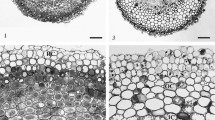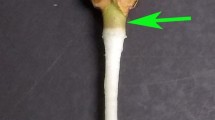Abstract.
In transmission electron microscopy studies, lanthanum ions have been used as electron-opaque tracers to delineate the apoplastic pathways for ion transport in barley (Hordeum vulgare L.) roots. To localize La3+ on the subcellular level, e.g. in cell walls and on the surface of membranes, electron-energy-loss spectroscopy and electron-spectroscopic imaging were used. Seminal and nodal roots were exposed for 30 min to 1 mM LaCl3 and 10 mM LaCl3, respectively. In seminal roots, possessing no exodermis, La3+ diffusion through the apoplast was stopped by the Casparian bands of the endodermis. In nodal roots with an exodermis, however, La3+ diffusion through the cortical apoplast had already stopped at the tight junctions of the exodermal cell walls resembling the Casparian bands of the endodermis. Therefore, we conclude that in some specialized roots such as the nodal roots of barley, the physiological role of the endodermis is largely performed by the exodermis.
Similar content being viewed by others
Author information
Authors and Affiliations
Additional information
Received: 28 July 1999 / Accepted: 24 February 2000
Rights and permissions
About this article
Cite this article
Lehmann, H., Stelzer, R., Holzamer, S. et al. Analytical electron microscopical investigations on the apoplastic pathways of lanthanum transport in barley roots. Planta 211, 816–822 (2000). https://doi.org/10.1007/s004250000346
Issue Date:
DOI: https://doi.org/10.1007/s004250000346




